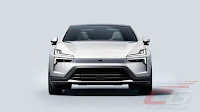Polestar, a Swedish EV brand owned by Volvo Cars, has taken a rather unique twist to the entire coupe/SUV thing: they’re actually making do without the rear windshield on their Polestar 4.
How the Polestar 4 fares against safety regulators is a question best asked another day, but here and now, the SUV coupe will head to production minus the rear windshield. Instead, the Swedish design team will rely on a high-def screen that’ll feed real-time images from a roof-mounted camera. These images, however, can be switched off allowing the driver to see their rear occupants instead.
Even more interesting is how the deletion of the rear window allows Polestar to have a standard full-length glass roof that extends beyond the rear occupants’ head creating, what the carmaker calls, a “unique interior ambience.” The glass roof itself can be made opaque thanks to its electrochromic properties.
In terms of mechanical bits, the Polestar 4 rides on Geely’s Sustainable Experience Architecture or SEA platform. And despite its compact-looking design, it’s rather chunky at 4,839 mm in length, 2,139 mm in width, and 1,544 mm in height (wheelbase is at 2,999 mm). With a 544-horsepower, 686 Nm dual electric motor setup, it’ll be the fastest production car the brand’s ever done with a 0 to 100 km/h sprint in 3.8 seconds. A single-motor version with 272 horsepower and 343 Nm will also be made available.
Sustainability plays a big role in the development of the Polestar 4 and with that, uses materials made up of 100 percent recycled PET, bio-attributed microtech vinyl (it uses pine oil instead of crude oil), and animal welfare-secured nappa leather.
The Polestar 4 will be produced in Hangzhou, China starting November at a Geely-owned facility that uses 100 percent renewable electricity. It will be sold in Europe, North America, and several markets in Asia-Pacific (sadly, it doesn’t include the Philippines) in 2024 with an indicative price of around USD 60,000 (P 3.364 million).










When the roof-mounted camera goes wrong, it can be a huge problem. Many blind spots.
ReplyDelete